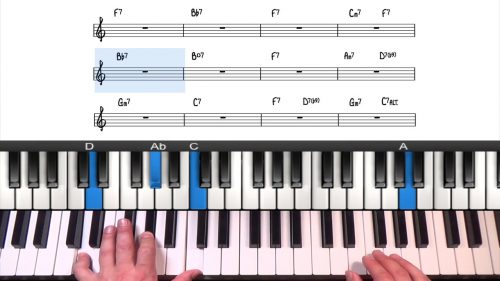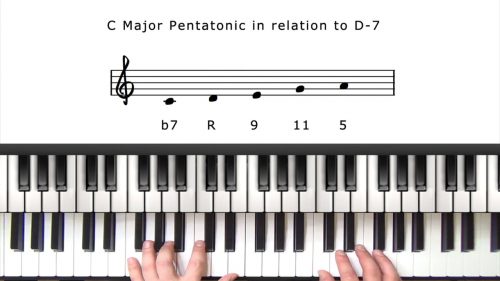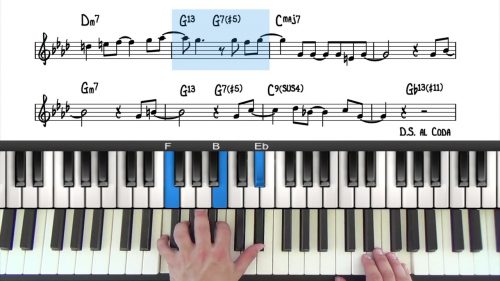Pentatonic Scale Improvisation
Welcome to lesson 3 in the Minor Blues course. In lessons 1 & 2, we covered the fundamentals of left hand voicings of chords in our standard 12 bar minor blues. We then introduced inversions, substitutions, passing chords, and turnarounds to add interest and variety to the chord changes.
In this lesson, we will introduce right hand improvising primarily using the notes of the minor pentatonic scale and the minor blues scale.
The Pentatonic Scale Explained
The major pentatonic scale can be defined by 5 scale degrees of the major scale, just as the minor pentatonic scale can be defined by 5 scale degrees of the natural minor scale.
Similar to the major and minor scale, the minor pentatonic scale is the relative minor of the major pentatonic scale. And each major pentatonic scale contains the same notes as some minor pentatonic scale built off the 5th scale degree of that major pentatonic scale (a major 6th above the major pentatonic’s root or a minor 3rd below)
Choosing Pentatonic Scales
We will start by playing the i minor pentatonic/blues over the whole form, examining the notes from the scale and what scale degrees they are for each chord.
Using just 1 pentatonic scale over the whole form will help you internalize each of the scale degrees of our minor blues, and hear exactly how they sound over each chord in the form. You should know what sound is going to come out when you press a certain key.
Starting with simple 2 or 3 note patterns, we will gradually increase the complexity of our lines. To start, you should focus on developing simple rhythmic lines, rather than learning complex licks
Pentatonic Scale Choices
Just like in the standard blues, you can play the minor pentatonic/blues of the iv chord over the iv chord itself. We will analyse the notes and scale degrees to see how this interacts with the harmony throughout the form.
Following this process will allow you to make wiser choices on note selection over the various chords in the progression.
Combining Pentatonic Scales
The next step is to combine the different pentatonic scales to create more melodic possibilities. We will explore how to combine the pentatonic and blues scales for C and F to access a wider pool of notes.
In the next lesson, we will explore and apply the dorian mode, various forms of minor scales, as well as the altered scale and half whole diminished scale.
Lesson Downloads
-
Minor Blues Progression PDF File Type: pdf
-
12 Minor Pentatonic Scales File Type: pdf
Practice Tips
-
The purpose of this lesson is to get students soloing and improvising with the right hand.
-
Ensure that you are confident with your left hand voicings so that you can focus your attention on your right hand lines.
-
Spend adequate time getting comfortable with these pentatonic scales for the C Minor Blues Progression.
-
Remember to relate each pentatonic scale back to their relative minor or major scales.
-
Think of the relative pentatonic scales as pairs to cut your work in half.
-
Focus on rhythm and on playing patterns, as well as any melodies you hear in your head.






Dear guru,
Sorry for this rather long draft. I am trying to summarize my understanding on Blues improvisation, be it Major or Minor. I would request you for your validation in this regard.
First, it is appropriate and okay to mix minor and major pentatonic scales on a case to case basis for both the Major and Minor Blues pieces. If we have a piece in minor we will want to stick to a minor (pentatonic) scale while if we have a piece in major, which is not meant to sound bluesy, we can to stick to a major (pentatonic) scale. This is a purist view. However, we can mix the two in blues context, i.e. either in a blues song, or in a piece where we want certain parts to sound a bit bluesy.
Blues is all about mixing notes from the major and the minor scales to make them sound like a pro. In a typical I-IV-V progression;
a)I7: both minor and major pentatonic work fine
b)IV7: minor pentatonic is OK, major pentatonic must be used carefully
c)V7: both minor and major pentatonic work fine
Having said this, its advised not to think of it in terms of switching between minor and major, but to hear the chord tones and add / improvise those tones to the basic scale, which could be the blues scale. Ans the best way to learn how to do it is to analyze players mentioned by you, who basically use all 12 notes to play over a blues.
Hope I am not sounding presumptuous. Still a newbie 😊
Regards,
Hey Shantanu,
Apologies for the late reply here… the comment notification was lost in my inbox!
Here’s a rule of thumb that I follow with major/minor blues sales.
If it’s a major harmony, for example a major 251, then the major blues scale from the Imaj7 chord will give you a very “happy” “cheery” and “gospel-esque” sound. For example, a 251 in F Major (G-7 / C7 / Fmaj7) – try playing the notes of the F Major Blues Scale – F-G-Ab-A-C-D
On the contrary, if we play the F Minor Blues Scale – F-Ab-Bb-B-C-Eb – you will hear that it sounds much “darker” and “bluesier”. When you get to the 1 chord (F Major) it sound nice to add in the major 3rd – A – and you can do this with a grace note from the Ab to the A. Similar to the licks that we looked at in the 12 bar blues course.
Check these lessons out regarding the Major Blues Scale & Georgia On My Mind:
Major Blues Scale: https://www.pianogroove.com/blues-piano-lessons/the-major-blues-scale/
Georgia Application: https://www.pianogroove.com/blues-piano-lessons/georgia-on-my-mind-tutorial/
Next, if you are playing in minor harmonies, this is when the minor blues scale is more effective. Check out this lesson where you can hear the minor blues scale and licks over the harmony of “Alone Together”:
https://www.pianogroove.com/jazz-piano-lessons/approach-patterns-target-notes/
Finally Shantanu, remember that the major pentatonic scale, and the major blues scale is pretty much the same thing, except the major blues scale just has the additional b3.
In addition, the minor blues scale, and the minor pentatonic scale is pretty much the same thing, except the minor blues scale has the addition b5.
And a very important thing for you to understand, is that every major blues scale/major pentatonic scale has its relative minor scale.
For example, F Major Pentatonic is the exact same notes as D Minor Pentatonic. And F Major Blues scale contains the exact same notes as D Minor Blues Scale.
And here’s where it gets interesting, any lick/line/pattern that you would play with D Minor Pentatonic, you could also play the exact same thing over F Major, and it would sound great. The same applies with an F Major Blues over D Minor Harmony.
Check out this lesson Shantanu on Pentatonic Scale Improvisation: https://www.pianogroove.com/jazz-piano-lessons/pentatonic-scale-improvisation/ – this will help you understand how these scales can be used over many different harmonies.
Hope this helps and sorry again for the late reply 🙂
Cheers!
Hayden
For me this has been a great lesson for learning to improvise (not too many chord changes!) but I’m confused about how blues scales are formed. With the C and F minor, he says to get a blues scale you add a flat 5 to the minor pentatoic. So far so good. But when we get to G7 he says to use the G major pentatonic , which would be G A B D E. To make that a blues scale I figured you’d add the flat 5 again (G A B Db D E). But when I looked it up it seems that the G major blues scale has a flat 3 as the 2nd degree in addition to the flat 5 (G Bb C Db D F)? But then elsewhere I found G major blues scale defined as G A Bb B D E, so just the added flat 3. Can anyone clarify the rule for making a major blues scale from a major pentatonic scale? Discussions of this online are confusing. Thanks! Sarah
Hi Sarah 👋
Great question!
I created a lesson on the major blues scale here: https://www.pianogroove.com/blues-piano-lessons/the-major-blues-scale/ – in this lesson we make the distinction between the major and minor blues scales.
Here is a quick summary:
Major blues scale = the major pentatonic scale with the b3 added.
Minor blues scale = the minor pentatonic scale with the b5 added.
Also remember the relative major and minor scale relationship which also applies to blues scales.
For example, the F major scale and D natural minor scale are relative and so they share the same notes.
In the same way, the F major blues scale contains the exact same notes as the D minor blues scale.
I explain this in more detail in the lesson referenced above.
Please let me know if i can help further.
Talk soon, Hayden